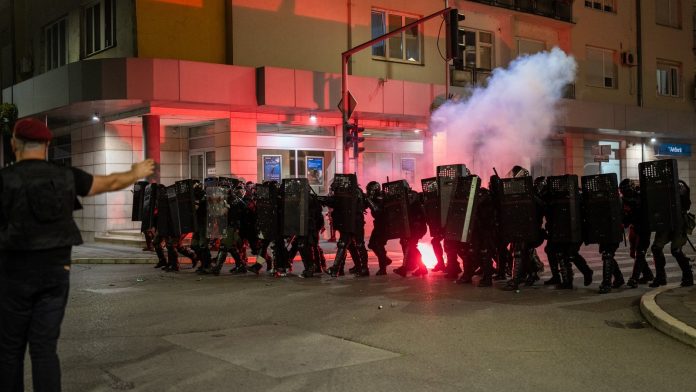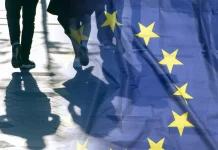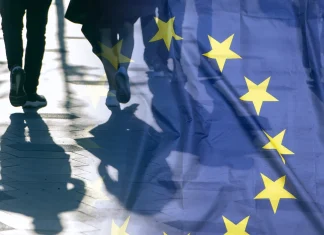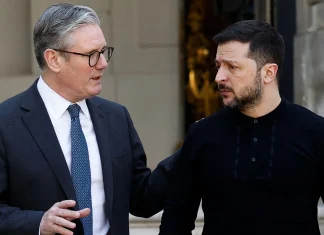Serbia’s Streets Ignite: A Nation’s Anguish and Unrest Unfold in Fiery Protests
As the sun set over Belgrade last night, casting long shadows on the Danube’s restless waters, a different kind of turbulence simmered through Serbia’s capital and spread to its cities. For the fifth night running, the air filled not with the usual din of city life but with the roar of defiant voices and the harsh clatter of confrontations. Protesters clashed once again with riot police, their frustrations echoing beyond the cobblestone streets, shaking the very core of a nation grappling with tragedy and distrust.
From Mourning to Mobilization: The Nation’s Pain Ignites
It all began with a heartbreaking calamity. In November, the catastrophic collapse of a railway station roof claimed 16 precious lives, a devastating event that pierced the collective Serbian conscience and unearthed a pool of long-simmering frustrations. This wasn’t merely about infrastructure failure—it soon morphed into a symbol of entrenched corruption, negligence, and a political establishment many citizens felt had long abandoned their promises.
“Our sorrow turned into outrage,” remarked Jelena Petrović, a teacher from Novi Sad. “We felt like our grief was being exploited or, worse, ignored by those we entrusted to protect us. That’s when the streets called us to speak not just for the victims but for the truth.”
The initial peaceful vigils swelled into magnitudes of public outrage. At their highest, demonstrations saw hundreds of thousands march in cities across Serbia. Patriotic hues mingled with banners demanding transparency and justice. But with the swelling crowds came rising tensions.
Valjevo’s Smoke and Shouts: Symbolism in Flames
In the industrial town of Valjevo, about 100 kilometers southwest of Belgrade, the protests transformed dramatically one night. What began as a massive, peaceful gathering morphed when a faction of young men, their faces deliberately veiled, targeted the local offices of the ruling Serbian Progressive Party (SNS). In a stark act of defiance and desperation, they set fire to the empty headquarters.
“It felt like burning down more than just a building,” said Marko Ilić, a student who witnessed the scene. “It was an outcry against a system that’s suffocating us.”
The ensuing melee was brutal. Fireworks erupted, stone-throwing punctuated by the sharp crack of stun grenades. Police released clouds of tear gas into the cold night air as the crowd surged and receded like a living thing—sometimes fragile, other times fiercely unyielding.
Belgrade and Beyond: Tensions Spread North
The capital itself was far from calm. Demonstrators on their way to the party center were blocked by heavy police presence, leading to hot confrontations amid chants filled with anger and hope. Similar disturbances flared up in Novi Sad, Serbia’s second-largest city, where long histories of cultural pride merged with current grievances in a volatile mix.
“It felt like the whole country was convulsing,” said Ana Kovačević, a journalist based in Novi Sad. “This is a genuine people’s movement, born from pain but burning with a determination to change the course of history.”
Violence and Allegations: A Nation Divided
While the demonstrations started with remarkable restraint, the atmosphere darkened sharply midweek. Pro-government supporters, often masked and wielding batons, launched coordinated attacks against the protesters. The violence escalated dramatically, drawing heavy condemnation from human rights advocates.
A particularly harrowing video circulated online, showing nearly 20 police officers surrounding and beating a young man lying powerless on the ground in Valjevo. Such evidence intensified fears that state power was being wielded as a tool of intimidation rather than protection.
“This is not how a democracy behaves,” said Dr. Milena Stanković, a political analyst. “When the state turns its force onto its own people, it risks fracturing the social contract irreparably.”
Yet, amid the turmoil, police have stood firm in their defense, asserting that they are responding to aggression from unruly elements within the protests themselves.
Political Earthquake: Fallout and Defiance
In response to the nonstop unrest, the Serbian government has already collapsed, with the prime minister resigning under immense public pressure. But the political waters remain choppy. President Aleksandar Vučić, the right-wing leader at the center of controversy, remains unyielding. He dismisses the protests as orchestrated foreign interference, casting himself as a bulwark against outside destabilization.
“To him, this is about power and narrative,” noted Dr. Stanković. “But to the people, it’s about dignity, justice, and the hope for a more accountable Serbia.”
What Do These Protests Mean for Serbia—and the World?
As you read this, consider the stakes. Serbia, a country straddling the crossroads of Eastern and Western Europe, wrestles with a fundamental question: Who holds the power, and how do ordinary people reclaim their voice in the corridors of power? Across the globe, nations experience waves of protest, yet few begin with such a raw and tragic spark.
The heavy-handed response by authorities raises wider concerns about the balance between security and rights—an eternal tension in democratic societies. Meanwhile, the demands for transparency and fairness resonate universally. After all, who among us wouldn’t want justice for the fallen and reform for the living?
In the gathering smoke and tear gas, beneath the riot shields and amidst the chants, something unmistakable is stirring: a desire for change, for honesty, for Serbia’s soul to emerge from the dark and battered but unbroken.
To the reader: What’s your take?
When tragedy exposes systemic failures, how should a society respond? Are protests the necessary voices of the unheard, or do they risk fracturing fragile orders? And in places where democracy is tested in real time, how do we, as part of a global community, stand in solidarity with those demanding their rights?
Serbia’s streets may burn tonight, but beyond the smoke lies a narrative unfolding—one of courage, reckoning, and, perhaps, something profoundly hopeful.










